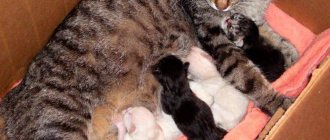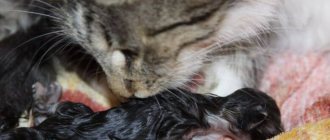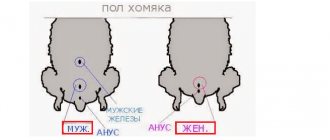A cat bears its offspring for 65–72 days. By the end of this period, the owner needs to know how, if necessary, to provide his pet with the necessary assistance. The first signs of impending lambing (as birth in cats is correctly called) appear about a week before the onset, and from that moment you need to begin preparing for such an important event.
Preparing for lambing
As the moment of delivery approaches, the cat changes its behavior:
- becomes restless;
- constantly licks the belly and the area under the tail;
- looking for a secluded place, trying to climb into the closet and arrange a bed.
Such changes begin about a week before lambing. Having noticed them, you need to make adjustments to the diet, reducing portion sizes and increasing the number of feedings. This is due to the fact that the kittens inside do not allow the stomach to stretch to its usual size.
The second step is to visit the veterinarian for a prenatal examination and obtain the necessary advice. Also, for a long-haired cat, the doctor can trim the hair near the tail and around the nipples, but this is also not difficult to do yourself.
If any deviations from the normal course of pregnancy are noted, it is better to have a specialist deliver the cat. If your pet is in good condition, you can accompany this process yourself.
Another preparatory moment is arranging a place for the future woman in labor. To do this, there is no need to purchase anything extra, since the animal will prefer a secluded place to any special bed. Therefore, it is recommended to take a regular but suitable-sized (quite spacious) box with a lid, cut a hole in the side and place a clean rag on the bottom. It is advisable to place it in a separate room where people rarely enter. Bowls for food and drink are located nearby, and a little further away there is a litter tray.
Signs of the onset of labor
A day before the onset of labor in a cat, the signs that appeared earlier are supplemented by another - a decrease in body temperature by 1°C. If the pet is accustomed to regularly measuring its temperature, then this method will help determine as accurately as possible the approach of delivery. If this procedure is new to the owner and the mother in labor, it is better not to start it at such a moment, but simply leave the animal alone.
Before you give birth to a cat, you must prepare a “rescue” set of tools and equipment, including:
- antiseptic and disinfectant;
- scissors, dental floss;
- pipette, baby syringe, disposable syringes
- surgical gloves
- gauze napkins;
- petrolatum;
- toilet paper;
- garbage bags;
- diaper;
- heater;
- stopwatch.
You should also have the veterinarian's phone number at hand. All this may not be necessary, but it is better to prepare for any development of the situation.
The immediate beginning of the labor process will be indicated by rapid breathing and the first contractions, during which the woman in labor usually meows and stretches her teeth towards her back. This stage can last from several hours to a day. At this time, you should not disturb the animal, and especially not arrange crowded viewings, since with excessive attention, the cat can eat newborn cubs.
The appearance of kittens
The first sign of the impending birth of a kitten is light, and then darker discharge, and a little later - attempts. The kitten is born approximately 25–35 minutes after the onset of such manifestations. The baby is born in the amniotic sac, which the cat bites through and then licks its face to remove mucus and open its nose for breathing. After this, it gnaws the umbilical cord and licks the entire body, activating blood flow and other vital functions.
Depending on how the cat’s birth progresses, you need to either not interfere or start helping. If the woman in labor manages to “process” each kitten before the next one arrives, then nothing needs to be done. When she failed to cope with one, and the birth of another baby has already begun, the algorithm of actions should be as follows:
- carefully release the kitten from the film and gently rub it with a sterile cloth;
- tie the umbilical cord with dental floss, cut it off and treat it with an antiseptic solution;
- make sure the newborn is breathing and place him next to his mother.
If there is no breathing, the airways should be cleared with a baby syringe. If this does not help, carefully turn the baby upside down, supporting the head, and bend it slightly, stimulating the outflow of fluid.
Normal and abnormal course of labor
Prevention of all possible complications during childbirth begins with caring for a pregnant cat. As soon as you discover that your pet is pregnant, regardless of whether mating was planned, she must be shown to a veterinarian.
A cat's pregnancy can be determined from 2–3 weeks using a blood test. At 3–4 weeks, the expectant mother's mammary glands swell. As the gestation period increases, the following signs are observed:
- Increased hunger.
- Redness of the nipples.
- Toxicosis.
- Slight but constant weight gain.
- Behavioral changes - frequent meowing, restlessness, unusual affection or irritability.
During the normal course of pregnancy, by about 5–6 weeks, the pet’s belly becomes noticeably rounded. If gestation proceeds without complications, the cat receives decent care, has no genetic defects, and birth occurs from 64 to 71 days of pregnancy.
It will be easier for an inexperienced owner to cope with the situation if the nest for birth is prepared in advance. It is necessary to monitor the cat’s behavior; most often, she herself chooses a suitable (from her point of view) place. You can take the initiative and equip a nest for your cat from a spacious box. In order for the expectant mother to feel safe, the box must be closed (have a roof).
During the first contractions, you may find that the cat is restless, constantly entering the nest, or looking for a suitable place to give birth to kittens.
The pet can meow loudly and attract the attention of the owner, especially if she is about to give birth for the first time. The first contractions bring discomfort, but the cat successfully hides the pain
The owner may not notice the discharge of amniotic fluid and the rejection of the mucous plug, since the cat licks the genital area.
As the labor process progresses, contractions will intensify and the interval between them will decrease. When the interval is reduced to 20–30 seconds, the cat will lie down on its side and prepare to push.
The first kitten takes longer to be born than all the others; to expel it, the cat will need to make 3-4 strong attempts. The total duration of the process from the start of contractions to the appearance of the first kitten can take from 2 to 24 hours. Normally, contractions last up to 12 hours, and pushing at the birth of the first kitten lasts up to 1 hour.
As soon as the baby is born, the cat licks its face, gnaws the umbilical cord and eats the afterbirth. If the woman in labor does not pay attention to the kitten, and the expulsion occurs too quickly, the pet may be in rapid labor. This complication is associated with severe pain, so it is advisable to immediately remove the kittens from the nest, remove fluid from the respiratory tract, rub them and place them on a heating pad.
Stages and duration
On average, labor in cats can last up to 26–36 hours if it goes without complications. In this case, the whole process is divided into 2 stages:
- within 24 hours the first signs are observed, the water breaks, the animal meows and licks itself;
- then the birth itself begins, the duration of which depends on the number of kittens.
After each baby, a placenta must be delivered, which the cat usually eats immediately (as well as stillborn kittens, if any). This process must be controlled, otherwise, after eating several afterbirths, the animal may experience an upset stomach.
In addition, control is necessary to track whether the number of placentas coincides with the number of babies born. A failed placenta can cause internal inflammation.
Premature birth in a cat: how to help
Premature birth in a cat is very rare and does not just happen. This often depends on the cat's breed and environmental factors. In non-pedigree cats, this phenomenon can occur without complications and death of offspring, unlike purebred cats.
If a purebred cat gives birth prematurely, it may lose its offspring or die itself, so you need to be very careful about this pathology.
In order to help the cat you need to look after it. Premature birth can begin very intensely and end with the kittens dying out, so they give medications to relieve stress. If it is impossible to help your cat at home, then you need to call a veterinarian.
Possible complications
Lambing does not always go well. Possible complications during childbirth in cats can be caused by a variety of reasons. Some difficulties can be dealt with on your own, but most problems that arise require urgent intervention from a veterinarian.
You should call your doctor immediately if one of the following situations occurs:
- the duration of pushing exceeds 1 hour, and the kittens have not begun to be born;
- the animal has become weak, apathetic, lies motionless or constantly meows, experiencing severe pain;
- the number of placentas is less than the number of newborns;
- clear blood discharge appeared;
- body temperature differs significantly from normal in one direction or another;
- contractions are sluggish and rarely repeat (with an interval of 30 minutes or more);
- The amniotic sac burst and the kitten got stuck in the birth canal.
Most of these signs are symptoms of uterine dystonia or atony, which requires urgent veterinary attention, often including a cesarean section. Any delay can be fatal for the cat and cubs. But in simpler situations, you can help the woman in labor yourself.
Stuck kitten
In such cases, the clinic resorts to caesarean section. To help yourself, you should rub your stomach in time with your pushing. It is absolutely forbidden to pull a newborn by the head, otherwise you can simply break the neck. You need to pull the baby by the skin or by the body. The movement should not be directed perpendicular to the animal’s body, but from side to side.
Premature birth
To determine the lambing date, it is necessary to take into account the breed of the animal and some subjective factors. In outbred cats, premature birth usually occurs without negative consequences for the mother and newborn babies. A purebred cat can not only lose kittens, but also die itself.
In order not to miss this moment, you need to constantly monitor the condition of the pregnant pet, taking into account that there is a high probability of intensive onset of labor. You can save a cat in such a situation with the help of special medications that reduce stress, and then contact a veterinarian.
Weakness/absence of contractions
The reasons for weakness or absence of contractions are usually due to poor nutrition and a lack of certain substances in the body (calcium, oxytocin). To eliminate the problem, oxytocin preparations or the administration of a calcium borogluconate solution are used. But inducing labor this way is too risky because it can cause uterine rupture. Therefore, in most cases, a caesarean section is performed, but also solely based on the feasibility of such an operation.
In itself, a caesarean section does not pose a threat to the life of the animal; it is performed under general anesthesia and allows you to save both the woman in labor and all her offspring. Some complications are possible only in the case of serious pathologies in the development of the placenta or intrauterine decomposition of the deceased fetus. In such situations, there is a high probability of complete removal of the uterus, which will make the cat infertile, but will help save her life.
Helping a cat give birth
A collection of tipsTHIS IS TIPS. TREATMENT AND RECOMMENDATIONS ARE TO THE Veterinarian. I AM ONLY A BREEDER.
giving birth to a cat, helping a cat during childbirth
A cat's gestation period is 58-72 days. If the cat’s labor is good, then there is no need to use medications before and during birth. After birth, two hours after the last kitten, oxytocin can be administered to better cleanse the uterus and increase milk lactation.
use of medications during cat birth For experienced breeders, this advice is unnecessary, but for beginners I want to remind you that you are not a veterinarian. Therefore, use medications very carefully and do not try to pour and inject everything into the cat. Improper use of medications can seriously harm your cat.
traumatin for a cat during childbirth Traumatin® acts on the neuroendocrine system, stimulates the production of endogenous (own) oxytocin, which leads to uterine contractions. In addition, Travmatin® has an analgesic and hemostatic effect. Even during normal childbirth without obstetric care, there is a risk of microtrauma to the mucous membrane of the cervix and vagina.
Therefore, Travmatin® should be administered both at the beginning of labor and at the end of the process. This allows you to avoid complications both during childbirth and in the postpartum period, prevents inflammatory diseases of the genital organs and promotes normal involution of the uterus (when the uterus returns to its original state).
The dosage of the drug for cats is 1 ml. Travmatin® is injected subcutaneously into the withers area or intramuscularly. In addition, the drug can be given orally in 5-15 drops (if it is impossible to give an injection, a very small or nervous animal), if necessary (weakening of labor in case of large fetuses or large litter size), frequent administration is possible (every 15-20 minutes).
If the postpartum period is accompanied by severe bleeding from the genitals, the animal must be given an injection of Travmatin® and consult a doctor immediately!
Don’t panic, stay calm, keep Travmatin® on hand, and your animal will give birth naturally and easily.
Gamavit for a cat during childbirth Subcutaneously, 2 ml before birth or during childbirth as needed. Gamavit is used to normalize labor in complicated cases. The drug stimulates the smooth muscles of the uterus, accelerating and facilitating the birth process, and promotes rapid cleansing of the uterine horns from dead fetuses.
We invite you to familiarize yourself with Small aquatic turtles at home
For weakened kittens, 0.01 ml subcutaneously.
oxytocin in a cat during childbirth Oxytocin has the ability to enhance contractions of the smooth muscle of the uterus and myoepithelium of the mammary gland.
Attention! Oxytocin can be released in different forms. Oxytocin 5 units and oxytocin 10 units. Recalculate the dosage in accordance with the purchased drug!
This drug is injected during weak labor. It causes contractions of the uterus. In most cases, oxytocin is not recommended until the first kitten is born. It is also strictly contraindicated in the case when the kitten is stuck in the birth canal.
Oxytocin is injected into the withers in a volume of 0.2-0.3 ml. One time. NOT INTO A FIGHT! If after 20 minutes there is no reaction, then inject again. In case of weak labor, they usually inject according to this scheme - 02. ml 3 times with a break of 20 minutes. You can inject intramuscularly, then the reaction will follow faster.
. Oxytocin is contraindicated during obstetrics in cases of a large fetus, its deformity, as well as in case of incorrect position and position.
a cocktail that stimulates labor in a cat. If you are afraid to administer oxytocin, administer a 10 ml s.c. cocktail. No risk at all, just pure benefit. Tested in prolonged labor.
The action of the cocktail is fundamentally different from the mechanism of action of oxytocin and similar drugs (oxytocin “works” at the level of nerve fibers, “forcing” the muscles of the uterus to contract, and the cocktail stimulates the contraction of the smallest blood vessels without affecting the nerves. Therefore, “uterine fatigue” does not is coming.
Moreover, if it is necessary to use oxytocin, it is recommended to inject such a cocktail “before that”.
In addition, the cocktail DOES NOT ALLOW uterine ruptures and bleeding, and the largest kittens are born remarkably and without problems only with its use (without the participation of oxytocin).
You can prick UNTIL INFINITY - as much as needed = uterine fatigue DOES NOT OCCUR.
The difference between subcutaneous, intramuscular and intravenous administration is the speed of action. Roughly speaking, the result occurs subcutaneously in 10 minutes, intramuscularly in 5 minutes, intravenously in an instant.
After the birth of Supposedly the last kitten, I always inject oxytocin. Cocktail - I inject for another 3 days after childbirth (1 injection per day, in the same dosage as during childbirth). and again - reinsurance, for possible eclampsia.
NOW THE RECIPE ITSELF: 4 ml (cube) glucose 4 ml (cube) calcium gluconate 2 ml (cube) ascorbic acid Select all components into one syringe, total volume = 10 ml (cube). Inject at the rate of 2 cubes per 10 kg of cat’s weight. Single dose for a medium-sized cat = 1 ml.
Inject after the birth of the first kitten.
Maintains the tone of the uterus and stimulates the release of clots, replenishes fluid loss and feeds, “washes out” the placenta, stimulates milk production. Very good during long labor.
cocktail to restore strength and energy calcium gluconate 10% -2 ml ascorbic acid - 1 ml glucose 5% - 7-10 ml For two subcutaneous injections of 10 ml every hour. The cat's weight is from 3.5 to 5 kg. Do you understand? not for stimulation, not for vitaminization, and not for prevention - To replenish what was lost.
This cocktail is used ONLY DURING childbirth (after 3-4 kittens) or AFTER BIRTH. To replenish lost: strength and energy (nutrition and fluids - glucose, stress relief and removal of toxins - vitamin C, calcium.)
calcium gluconate during cat birthCalcium gluconate or calcium borogluconate (1 ml intramuscularly)
Calcium gluconate is injected only INTRAMUSCULARLY (.), warmed up to body temperature (the required amount is drawn into a syringe and held in the hand until it warms up).
The drug gently enhances contractions and labor, and also promotes milk production. During childbirth, calcium is injected when regular contractions begin (see the cat's condition, if necessary). 1 ml at a time, bring to 4 ml.
We suggest you read How to clean your cat's ears at home
After childbirth, a prophylactic dose of 1 ml once a week. If the cat shows the first signs of eclampsia, give it 1 ml in the morning and 1 ml in the evening for three days.
To relieve an attack of eclampsia, inject 2 ml, repeat after 30 minutes until the attack is completely relieved. The maximum total dose is 10 ml. You can drink calcium gluconate, but it’s useless!
In addition, it is advisable to give the cat a sedative; with the sedative, the signs of the disease go away much faster.
The veterinary drug calcium borgluconate is injected INSTEAD of calcium gluconate according to the same scheme, subcutaneously or intramuscularly. Do not solder.
Traumeel (traumatin) one drop in the mouth of a weakened kitten every 15 minutes for two hours. For cats, 0.5–2 ml subcutaneously or intramuscularly to relieve pain.
helping a cat during childbirth if the kitten gets stuck at the exit During the normal course of childbirth, you should not interfere with this natural process, you can simply help the female.
If the cat has pinched the kitten out of pain and fear, for example, in the neck area (i.e. body out, head in), then by gently pulling you can try to speed up the birth. This is especially important in breech presentation, when compression of the umbilical cord is possible. At the same time, oxygen ceases to enter the fetal body, as a result of which a reflex inhalation follows and amniotic fluid enters the lungs.
With a cephalic presentation, the membranes are open, air can pass into the lungs during breathing movements. It is better to pull the fetus by the folds of skin on the neck or torso, always during pushing, carefully, but quite strongly, as if in an arc - outward and downward. If the birth canal is dry, it needs to be moistened.
a bubble is sticking out. If it is a bubble that is sticking out, then you don’t need to do anything, just don’t let the cat bite through it. You can begin mechanical stimulation of contractions.
the cat does not bite the umbilical cord. The kitten “hangs” on the umbilical cord. We free the kitten's nose from the amniotic sac. Grasp the umbilical cord with your thumb and forefinger as close to the cat's vulva as possible. During the contraction we stretch. If there are no contractions, but the cat jumps up and spins around, sits down (risk of crushing the kitten), cut it off.
Ideally, of course, use a medical clamp. The umbilical cord was clamped. Cut off from the kitten's side. The remainder of the umbilical cord is secured with a clamp from the outside and will not go back into the cat. We bring the kitten back to life. Then we put it to the mother, she is distracted by it (licks it), and you take the clamp in your hands and remove the afterbirth.
the placenta does not come out. If the placenta hanging from the genital slit does not separate within half an hour or interferes with the birth of the next fetus, it is carefully removed by hand.
mechanical stimulation of contractions We fix the cat in the “pooping” position. Gently massage the abdomen using circular movements. We put on gloves, dip a finger in Vaseline oil, insert it into the vagina 1 cm and make circular movements. If a bubble sticks out, then massage it around until contractions appear.
The pages, links to which are given below, are a kind of treasury of experience, both mine and other breeders. There are situations when you urgently need to help a cat or kitten, but the doctor is busy (the veterinary clinic is far away, at night...). Therefore, I decided to collect and write down (on the website) various tips for this or that situation.
After childbirth
Babies begin to suck mother's milk immediately after birth. It is especially important that all newborns breastfeed immediately, since the first milk, called colostrum, is essential for the normal development of kittens. It contains special antibodies that are passed from mother to calf and support its immunity while it develops its own.
If the babies’ health worsens or the mother’s unwillingness to let them near the nipples, urgent help from a veterinarian is needed. A way out of this situation may be tube feeding.
In any case, the cat should be examined by a veterinarian the day after lambing to check its condition. In addition, the doctor will examine the kittens and determine whether they have enough mother's milk, both in quantity and quality.
If everything is going well for the cat and its offspring, you need to leave them alone for at least 1 month. The only exceptions should be cleaning the box, feeding and periodically checking the condition of the new family.
Complications during childbirth
It happens that the normal course of labor may be interrupted by certain complications. The owner needs to be very careful, especially if the cat is giving birth for the first time.
How to help a cat during childbirth and what can cause complications?
What to do if a cat develops a bladder during childbirth
Most often, the amniotic sac ruptures while still inside the woman in labor. If the entire bubble comes out, you can help the cat break it by first disinfecting your hands.
What to do if the kitten is born too big
You need to wait for the kitten to partially emerge during the contraction, then carefully use your index finger, pre-lubricated with Vaseline oil, to move the skin from inside the cat’s vagina closer to the anus. And then you need to carefully grab the kitten and move it from side to side with gentle movements, thus helping it to be born.
What to do if a cat gives birth to dead kittens
If a cat cannot give birth to dead kittens, she definitely needs help. The only difference is that the kitten can be pulled by any part of the body, just to free the woman in labor from the dead fetus, so that severe inflammation with subsequent infection does not occur.











